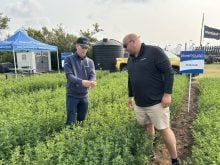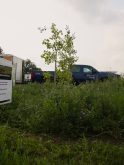Forages have a place on larger farms but farmers need more information and new management systems to get the most out of them .
Ken Wall, a professional agrologist with Federated Co-operatives Ltd., spoke recently at the Canadian Forage and Grasslands Association annual meeting in Harrison Hot Springs, B.C.
He said there is a hunger for forage-based knowledge. Federated Co-op, a Saskatoon-based organization run by member co-ops throughout the West, offers forage programs and producer partnerships designed to help owners with larger land holdings learn about potential land improvements that will make them money. Wall said it has revealed a discrepancy in forage management knowledge.
Read Also

Crop quality looks good this year across Prairies
Crop quality looks real good this year, with the exception of durum.
“Fifty to 100 people show up at a time for these meetings,” said Wall, who added there are increasingly more farms with land parcels of 20,0000 to 50,0000 acres and their owners aren’t profiting from many of the acres.
One farmer in Swift Current, Sask., experimented with 1,500 acres of his larger acreage and seeded it into forage. Two years later, he got the highest net return on a forage mix, which was hayed and piled by the highway and later auctioned off at $220 per ton and he yielded two tonnes per acre.
Wall fields questions about legumes and forages in an oilseeds and cereals rotation. This rotation increases soil fertility and improves grain yields. It also helps to break pest cycles. The benefits have been greatest in more moist environments.
The 14th annual CFGA conference brought together technical speakers on forage production, markets and how forages fit into the drive for more climate resilience.
CFGA’s main role is to promote the forage industry and boost domestic and export markets. But it also plays a role in the education and support of producers whose livelihoods depend on forage production, for resale or for feeding livestock. The CFGA has partnered with other organizations.
Regeneration Canada, based in Montreal, is one such organization. Saskatchewan rancher Ross McDonald has been a board member, adding his larger-scale production knowledge to a smaller farm-focused board. MacDonald described Regeneration Canada as a portal through which land managers can share climate solutions through open communication in a respectful setting.
Andrew Rushmere, director for Farmers for Climate Solutions (FCS), said the organization has 29 member organizations, which include more than 20,000 producers across the country.
FCS creates models to help government policy development. It focuses on bridge building and is solutions oriented to minimize polarization on sensitive policy issues.
Rushmere said during the last three years, farmers have been on the front lines of a major wake-up call. He said there is a growing recognition that knowledge changes are needed. Their organization helps farmers mitigate climate change challenges.
Nitrogen management, advanced grazing systems and cover cropping is a focus of their programming at www.farmlearninghub.ca.
Rushmere said they promote farmers as the solution.
“Agriculture is the only sector predicted to have increased emissions by 2050,” said Rushmere. “We don’t believe that’s inevitable.” In fact, he said data from agriculture indicates this sector can reduce emissions by 25 percent by 2030.
FCS plans to offer a series of three three-day meetings this winter to present solutions to farmers, whether or not they are climate change advocates.

















